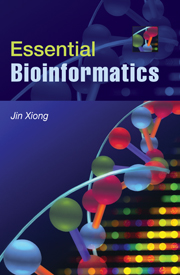Book contents
- Frontmatter
- Contents
- Preface
- SECTION I INTRODUCTION AND BIOLOGICAL DATABASES
- SECTION II SEQUENCE ALIGNMENT
- SECTION III GENE AND PROMOTER PREDICTION
- SECTION IV MOLECULAR PHYLOGENETICS
- 10 Phylogenetics Basics
- 11 Phylogenetic Tree Construction Methods and Programs
- SECTION V STRUCTURAL BIOINFORMATICS
- SECTION V GENOMICS AND PROTEOMICS
- APPENDIX
- Index
- Plate section
- References
11 - Phylogenetic Tree Construction Methods and Programs
Published online by Cambridge University Press: 05 June 2012
- Frontmatter
- Contents
- Preface
- SECTION I INTRODUCTION AND BIOLOGICAL DATABASES
- SECTION II SEQUENCE ALIGNMENT
- SECTION III GENE AND PROMOTER PREDICTION
- SECTION IV MOLECULAR PHYLOGENETICS
- 10 Phylogenetics Basics
- 11 Phylogenetic Tree Construction Methods and Programs
- SECTION V STRUCTURAL BIOINFORMATICS
- SECTION V GENOMICS AND PROTEOMICS
- APPENDIX
- Index
- Plate section
- References
Summary
To continue discussion of molecular phylogenetics from Chapter 10, this chapter introduces the theory behind various phylogenetic tree construction methods along with the strategies used for executing the tree construction.
There are currently two main categories of tree-building methods, each having advantages and limitations. The first category is based on discrete characters, which are molecular sequences from individual taxa. The basic assumption is that characters at corresponding positions in a multiple sequence alignment are homologous among the sequences involved. Therefore, the character states of the common ancestor can be traced from this dataset. Another assumption is that each character evolves independently and is therefore treated as an individual evolutionary unit. The second category of phylogenetic methods is based on distance, which is the amount of dissimilarity between pairs of sequences, computed on the basis of sequence alignment. The distance-based methods assume that all sequences involved are homologous and that tree branches are additive, meaning that the distance between two taxa equals the sum of all branch lengths connecting them. More details on procedures and assumptions for each type of phylogenetic method are described.
DISTANCE-BASED METHODS
As mentioned in Chapter 10, true evolutionary distances between sequences can be calculated from observed distances after correction using a variety of evolutionary models. The computed evolutionary distances can be used to construct a matrix of distances between all individual pairs of taxa. Based on the pairwise distance scores in the matrix, a phylogenetic tree can be constructed for all the taxa involved.
- Type
- Chapter
- Information
- Essential Bioinformatics , pp. 142 - 170Publisher: Cambridge University PressPrint publication year: 2006



